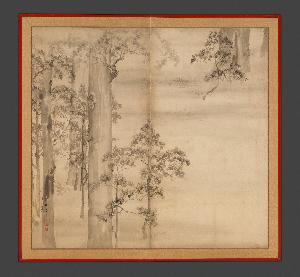Ikeda Koson
Ikeda Koson
Place: Echigo
Born: 1801
Death: 1866
Biography:
Early Life and Training
Ikeda Koson, a renowned Japanese painter, was born in 1801 in Echigo province (modern Niigata Prefecture). Little is known about his early life, but it is documented that he moved to Edo (modern Tokyo) to pursue his artistic career. Sakai Hōitsu (1761-1828), a leading figure of the Rinpa school, took Koson under his wing, providing him with the necessary training in painting.
Artistic Style and Contributions
Koson's work is characterized by its fresh vitality, bringing new life to standard themes within the Rinpa repertoire. His virtuoso brushwork and ability to convey naturalistic forms without sacrificing the bold decorative impact of his predecessors are notable aspects of his art.
Notable Works and Exhibitions
Some of Koson's notable works include:
- Chinese Literary Gathering, a hanging scroll showcasing his skill in capturing the essence of Chinese literary gatherings.
- Cypresses, a dramatic close-up of a single landscape element, demonstrating his mastery of ink tones and texture.
- A series of paintings closely related to Sakai Hōitsu's set, depicting court festivals (gosekku), which were adapted from Chinese practices and celebrated in Japan since the Nara period.
- Suzuki Kiitsu's influence on Koson's work, particularly in his landscape paintings.
- Nonoyama Kōzan's similarities with Koson in their use of bold decorative elements.
Museums and Collections
Koson's work can be found in various museums, including:- The Metropolitan Museum of Art, which features his painting Cypresses.
- British Museum, where his biography is documented.
Legacy
Ikeda Koson's contributions to Japanese painting are undeniable, and his work continues to inspire artists and art enthusiasts alike. His ability to bring new life to traditional themes has cemented his place in the history of Japanese art. Important Links:- The Nanga Art Movement, which influenced Koson's style.
- Ikeda Koson - Wikipedia, a comprehensive source for his biography.


